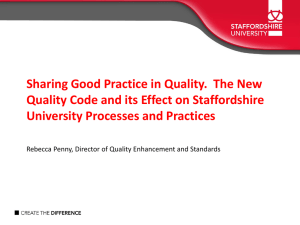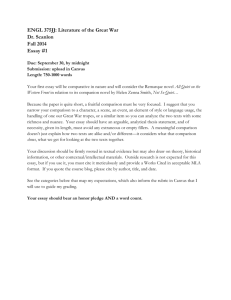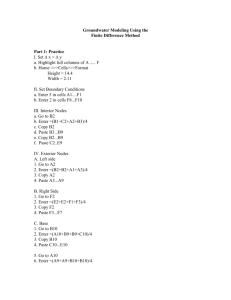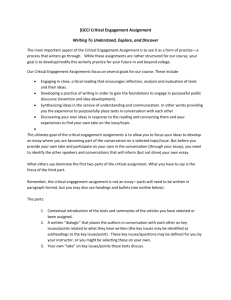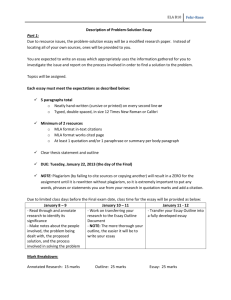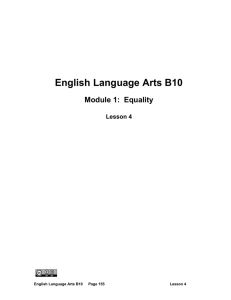Equity and Ethics
advertisement
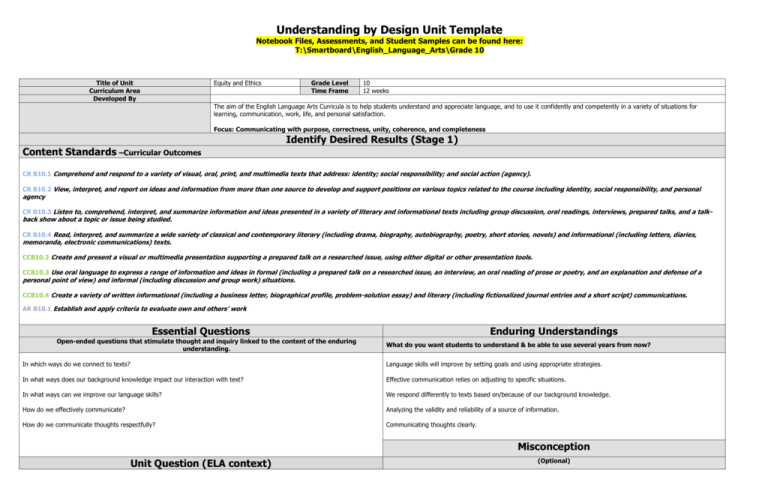
Understanding by Design Unit Template Notebook Files, Assessments, and Student Samples can be found here: T:\Smartboard\English_Language_Arts\Grade 10 Title of Unit Curriculum Area Developed By Equity and Ethics Grade Level Time Frame 10 12 weeks The aim of the English Language Arts Curricula is to help students understand and appreciate language, and to use it confidently and competently in a variety of situations for learning, communication, work, life, and personal satisfaction. Focus: Communicating with purpose, correctness, unity, coherence, and completeness Identify Desired Results (Stage 1) Content Standards –Curricular Outcomes CR B10.1 Comprehend and respond to a variety of visual, oral, print, and multimedia texts that address: identity; social responsibility; and social action (agency). CR B10.2 View, interpret, and report on ideas and information from more than one source to develop and support positions on various topics related to the course including identity, social responsibility, and personal agency CR B10.3 Listen to, comprehend, interpret, and summarize information and ideas presented in a variety of literary and informational texts including group discussion, oral readings, interviews, prepared talks, and a talk- back show about a topic or issue being studied. CR B10.4 Read, interpret, and summarize a wide variety of classical and contemporary literary (including drama, biography, autobiography, poetry, short stories, novels) and informational (including letters, diaries, memoranda, electronic communications) texts. CCB10.2 Create and present a visual or multimedia presentation supporting a prepared talk on a researched issue, using either digital or other presentation tools. CCB10.3 Use oral language to express a range of information and ideas in formal (including a prepared talk on a researched issue, an interview, an oral reading of prose or poetry, and an explanation and defense of a personal point of view) and informal (including discussion and group work) situations. CCB10.4 Create a variety of written informational (including a business letter, biographical profile, problem-solution essay) and literary (including fictionalized journal entries and a short script) communications. AR B10.1 Establish and apply criteria to evaluate own and others’ work Essential Questions Open-ended questions that stimulate thought and inquiry linked to the content of the enduring understanding. Enduring Understandings What do you want students to understand & be able to use several years from now? In which ways do we connect to texts? Language skills will improve by setting goals and using appropriate strategies. In what ways does our background knowledge impact our interaction with text? Effective communication relies on adjusting to specific situations. In what ways can we improve our language skills? We respond differently to texts based on/because of our background knowledge. How do we effectively communicate? Analyzing the validity and reliability of a source of information. How do we communicate thoughts respectfully? Communicating thoughts clearly. Misconception Unit Question (ELA context) (Optional) What are some of the factors that create inequalities? How have inequalities shaped our world? What is the role and responsibility in addressing inequalities? What is the relationship between rights and responsibilities? Who decides what is right? Why should we do the right thing? How can I act on the right thing? How does one become an ethical person? Knowledge Skills Students will know… Students will be able to… The following terms: CR B10.1 Comprehend and respond to a variety of visual, oral, print, and multimedia texts that address: identity; social responsibility; and social action (agency). Identity Group Discussions BDA Text Connections Effective communication Elements of Discourse Cues and Conventions Goal Plan Improving Personal Language learning Understandings Skills Strategies Contributions Evaluate Apply personal experiences and prior knowledge of texts and language to develop understanding and interpretations of variety of texts. (A) Identify how human experiences and values are reflected in texts. (E) CR B10.2 View, interpret, and report on ideas and information from more than one source to develop and support positions on various topics related to the course including identity, social responsibility, and personal agency Select, use, and evaluate purposefully a variety of before (page 24), during (page 25), and after (page 26) strategies to construct meaning when viewing. (B) Evaluate how genders and various cultures and socio-economic groups are portrayed in representations by the mass media. (E) Prepare and present critical response to what was viewed. (H) CR B10.3 Listen to, comprehend, interpret, and summarize information and ideas presented in a variety of literary and informational texts including group discussion, oral readings, interviews, prepared talks, and a talk-back show about a topic or issue being studied. Select, use, and evaluate purposefully a variety of before (page 24), during (page 25), and after (page 26) strategies to construct meaning when listening. (B) Demonstrate active listening behaviour (D) Understand the factors that interfere with good listening (e.g., environment, speaker, listener) and filter out distractions. (E) Formulate and support judgements (using convincing evidence) about the ideas under discussion. (H) CR B10.4 Read, interpret, and summarize a wide variety of classical and contemporary literary (including drama, biography, autobiography, poetry, short stories, novels) and informational (including letters, diaries, memoranda, electronic communications) texts. Demonstrate active reading behaviours (D) - Describe, discuss, and analyze the distinctive conventions, structures, and language features of a range of texts and explain how they suit the topic and purpose. (G) Read and interpret critically the main ideas, events, and themes of a variety of literary texts including stories, novels, scripts, poetry, and non-fiction works, and prepare and present critical responses to what was read. (J) Read and make generalizations, supported by specific details and examples, about key concepts, characters, themes, and techniques in literary texts. (K) CCB10.2 Create and present a visual or multimedia presentation supporting a prepared talk on a researched issue, using either digital or other presentation tools. Select, interpret, and synthesize information from visual texts and present it effectively, using a range of visual and layout features and appropriate technologies for variety of purposes. (D) Develop imaginative or creative representations to share interpretations and ideas. (H) CCB10.3 Use oral language to express a range of information and ideas in formal (including a prepared talk on a researched issue, an interview, an oral reading of prose or poetry, and an explanation and defense of a personal point of view) and informal (including discussion and group work) situations. Participate in small- and large-group discussion, observing the courtesies of group discussion, and demonstrate effective group interaction skills and strategies (A) Use oral language to interact purposefully, confidently, and appropriately in a variety of situations including participating in one-to-one, small-group, and large-group discussions (demonstrating an awareness of the relationship of language to group and community membership, acknowledging and paraphrasing views that differ from own, reassessing own viewpoints, prompting and supporting others, solving problems, resolving conflicts, building consensus, articulating and explaining personal viewpoint, discussing preferences, speaking to extend current understanding, and celebrating special events and accomplishments). (D) Recognize and use elements of classical speech forms (including introduction, body with transitions, conclusion) in formulating rational arguments and apply the art of persuasion. (I) Recognize and adjust oral presentation elements (i.e., articulation, pronunciation, volume, tempo, pitch, stress, gestures, eye contact, facial expression, and poise) in keeping with purpose, audience needs, and situation. (J) CCB10.4 Create a variety of written informational (including a business letter, biographical profile, problem-solution essay) and literary (including fictionalized journal entries and a short script) communications. Write a biographical profile that: includes key ideas learned about the person begins by sharing some important background information describes the subject and explains what he or she accomplished ends by leaving the readers with something to think about and consider (E) Write a problem-solution essay (e.g., an essay in which you analyze a problem and present one or more solutions) that : focuses on a problem that is important to self identities the problem in a clear statement analyzes the problem thoroughly, explaining its parts, history, and causes weighs possible solutions, what is being done to address the problems, and suggestions or solutions determines what readers need to know explains why situation exists and how it can be fixed includes all the important facts and reasons ends effectively explaining what the writer would like to see done. (F) Write fictionalized journal entries (e.g., of a literary character or a historical figure) that: o o o o o o o o o o o o o o o o focus on a made-up character or someone read about or observed focus on an ongoing event or experience contain impressions, reflections, and observations about life, people, and experiences give insight into the personality and values of the character. (H) AR B10.1 Establish and apply criteria to evaluate own and others’ work Use feedback to evaluate own effectiveness as a communicator. (A) Evaluate own and others’ contributions to group process and provide support where needed. (B) Set goals in language learning and use; identify strategies to achieve those goals. (C) Consider alternative ways of reaching goals. (D) Celebrate special accomplishments by using language to describe and discuss achievements. (E) Assessment Evidence (Stage 2) Performance Task Description The PERFORMANCE TASK describes the learning activity in “story” form. Typically, the P.T. describes a scenario or situation that requires students to apply knowledge and skills to Helpful tips for writing a performance demonstrate their understanding in a real life situation. Describe your performance task scenario below: 1) 2) 3) task. Boy in Striped Pajamas – see handout Biographical Profile – see handout Problem-Solution Essay and Prepared talk on researched issue – see handout Goal: What should students accomplish by completing this task? Role: What role (perspective) will your students be taking? Audience: Who is the relevant audience? Situation: The context or challenge provided to the student. Product/Performance: What product/performance will the student create? Standards (Create the rubric for the Performance Task) BLOOMS TAXONOMY: REMEMBERING: Can the students recall or remember the information? UNDERSTANDING: Can the students explain ideas or concepts? APPLYING: Can the students use the information in a new way? ANALYZING: Can the students distinguish between the different parts? EVALUATING: Can the students justify a stand or decision? CREATING: Can the students create new product or point of view? Digital Taxonomy for Bloom: KNOWLEDGE: Highlighting, bookmarking, social networking, searching, googling COMPREHENSION: Advanced searches, blog journaling, twittering, commenting APPLICATION: Running, loading, playing, operating, hacking, uploading, sharing, editing ANALYSIS: Mashing, linking, tagging, validating, cracking, reverse-engineering SYNTHESIS: Programming, filming, animating, blogging, wiki-ing, publishing, podcasting, video casting EVALUATION: Blog commenting, reviewing, posting, moderating, collaborating, networking, posting moderating Standards Rubric The STANDARDS RUBRIC should identify how student understanding will be measured. ELA B10 RUBRIC The Boy in the Striped Pajamas See The Boy in the Striped Pajamas Handout Biographical Profile See Biographical Profile Student Handout Equity and Ethics within Society See Problem-Solution Essay, Prepared Talk on Researched Issue, and Presentation Handout Other Assessment Evidence: Conversation What do you consider key ideas? What does an effective communicator look like? (Formative and summative assessments used throughout the unit to arrive at the outcomes.) Observation Co-operative learning through conversation and experimentation Product Journal entries, recreated pictures, speak poetry, responses to listening and viewing activities Biographical Profile Problem-Solution Essay, Prepared Talk on Researched Issue, and Presentation Learning Plan (Stage 3) Where are your students headed? Where have they been? How will you make sure the students know where they are going? In grade 9 ELA students learned about “doing the right thing” in their Social, Cultural, and Historical context. In grade 10 ELA students will continue to further their understanding of this concept in the “equity and ethics” theme. They will learn about their responsibilities to maintain equity in the “moving forward” theme from ELA 20. How will you hook students at the beginning of the unit? (motivational set) Students will research a variety of World War II topics to gain a better understanding of the context of the novel The Boy in the Striped Pajamas. What events will help students experience and explore the enduring understandings and essential questions in the unit? How will you equip them with needed skills and knowledge? How will you organize and sequence the learning activities to optimize the engagement and achievement of all students? Time Frame 1) 2) 3) The Boy In The Striped Pajamas Novel Study (4 weeks) Students will be divided into 6 different groups with a specific task for 3 different chapters. Each group will rotate through to complete the outcome task. There are some individual tasks and some group tasks. Each group member will have a chance to self and peer evaluate the contribution made at the end of the novel study CR B10.2 – Listen to the chapters without a book and answer two of the theme questions for Equity and Ethics CR B10.3 – Read and then view the section of the movie corresponding to the assigned chapters for that task. CR B10.4 – Reading- response to questions CC B10.2 – Representing – recreation and explanation of an image found online CC B10.3 – Speaking – Present a poem (h) to the class and provide an explanation of how it related to the theme, setting, or characters within your assigned chapters. CC B10.4 – Journal Entry (h) AR B10. 1- Reflection of self and group assessment Segregation – (3 days reading, watching, listening; 4 days to write Biographical Profile) CR B10.4 i. Move Your Shadow (Essay) ii. Rosa Parks (Biography) iii. Martin Luther King (Autobiography) iv. Montgomery Boycott (Essay) CR B10. 2- Rosa Parks Interview CC B10.4 – Biographical Profile – 4 days Equity and Ethics within Society (3 weeks) Discuss a variety of current ethical and equity issues facing our current world that we live in. CR B10.1 & 4 i. Ambition (Poem) ii. Please Come For Dinner (Essay) iii. Waiting on the World To Change (Poem) iv. Imagine (Poem) v. Dear Mr. President (Poem) vi. The Conversation of Birds (Short Story) ???? CR B10. 2 – View music videos and analyze techniques used to support presentation of song lyrics vii. Presentation of TED talks CR B10. 3 - Listen to sound of poems (lyrics of songs) CC B10.2 – Presentation representation (Prezi, powerpoint, etc.) for Problem- Solution Essay CC B10.3 – Prepared talk on Problem-Solution Essay 1) BSP - 4 weeks 2) 7 days 3) 11 days [5-6 days analyzing literature, TED talks, ; 5-6 days Problem- Solution Essay, Presentation (speaking)] How will you cause students to reflect and rethink? How will you guide them in rehearsing, revising, and refining their work based on your essential questions and enduring understandings? Students will provide constant feedback to each other while working on their current task. Students will assess themselves and their group members at the end of each task. At the end of the novel study students will hand in their peer and self-evaluations of the contributions each member made. Discussions will occur during class to help guide students in their learning and understanding of the essential questions and enduring understandings. How will you help students to exhibit and self-evaluate their growing skills, knowledge, and understanding throughout the unit? Students will use BDA strategies and include feedback from the teacher and peers to improve quality of work. How will you tailor and otherwise personalize the learning plan to optimize the engagement and effectiveness of ALL students, without compromising the goals of the unit? Students will have opportunity to demonstrate their understanding and knowledge of what they are reading, listening, and viewing, by creating representations, speaking, and writing. To achieve maximum understanding students will assess and reflect throughout their learning process. Students who require additional support were given time to work with an EA and expectations were adapted. What resources will you use in the learning experiences to meet the outcomes? Many resources including essays, short stories, poems, novels, audiobooks, and visual aids were used to meet the outcomes. (See above list) Assess and Reflect (Stage 4) Required Areas of Study: Is there alignment between outcomes, performance assessment and learning experiences? BAL’s: Does my unit promote life long learning, encourage the development of self and community, and engage students? CELS & CCC’s: Do the learning experiences allow learners to use multiple literacies while constructing knowledge, demonstrating social responsibility, and acting autonomously in their world? Adaptive Dimension: Have I made purposeful adjustments to the curriculum content (not outcomes), instructional practices, and/or the learning environment to meet the learning needs of all my students? Instructional Approaches: Do I use a variety of teacher directed and student centered instructional approaches? Student Evaluation: Have I included formative and summative assessments reflective of student needs and interests based on curricular outcomes? Resource Based Learning: Do the students have access to various resources on an ongoing basis? FNM/I Content and Perspectives/Gender Equity/Multicultural Education: Have I nurtured and promoted diversity while honoring each child’s identity? Blueprint for Life: Have I planned learning experiences in the unit that prepare students for a balanced life and/or work career? Adapted from: Wiggins, Grant and J. McTighe. (1998). Understanding by Design, Association for Supervision and Curriculum Development. Yes, performance assessments met multiple outcomes and provided a variety of learning experiences to play to the strengths of each learner. Yes, the themes in the ELA B10 curriculum expose students to social issues that they will hopefully be motivated to address in their future. Yes, students participated in activities from each receptive ELA strand; viewing, listening, and reading. Yes, adapting assignment expectations and using EA support for students who need additional guidance. Students who excel were given leadership opportunities during group work. Yes, students were engaged in teacher directed lessons as well as inquiry based learning. Yes, students were given feedback on formative assessments and were given the opportunity to reassess a summative assessment. Yes, see above. Yes, by strategically choosing the literature students were exposed to diversity. Yes, students were expected to work cooperatively in a group setting.



